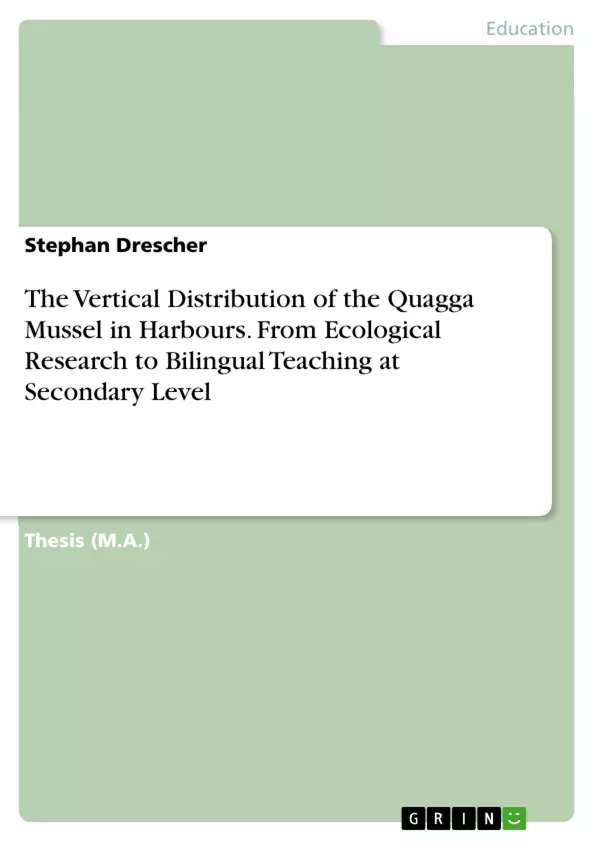The Quagga mussel (Dreissena bugensis rostriformis) is a non-indigenous species that has been recorded in Germany for the first time in the Main river, east of Würzburg in 2007 (VAN
DER VELDE & PLATVOET 2007). In October 2007 the Quagga mussel has been recorded at several harbors of the upper Rhine as in the Rheinhafen Karlsruhe, the Ölhafen and the
Industriehafen Mannheim (MARTENS et al. 2007), latter being the locality were samples were taken for this study. D. rostriformis bugensis is closely related to the Zebra mussel (Dreissena polymorpha), which has been recorded in the upper Rhine close to Mannheim around 1840
(REY et al. 2004).
Both species are so called “invasive species” defining them as animals, which “have entered an environment after 1492 (beginning of modern times), that has not been accessible before, to establish new potential populations. This progress happens intended or unintended with direct or indirect involvement of human being” (own translation from German; KINZELBACH 1996) Invasive species are found in many various fauna groups and they often differ in their invasive strategy. D. polymorpha and D. bugensis are both examples of r – strategy;
animal groups with a high reproductive potential, which are usually undemanding generalists (REY et al. 2004).
The origin of the Zebra and the Quagga mussel is the northwestern part of the Black Sea and some estuaries (ORLOVA et al. 2004, VAN DER VELDE & PLATVOET 2007). The natural dispersal of Dreissenidae happens mainly by larval drift enhanced by currents, or water birds which spread larvae attached to them. But human influence allows these species to cope with larger distances and to cross their natural barriers. Veliger larvae of Dreissenidae can settle on boats or they are being transported within the ballast water of ships, allowing them to move upstream. So shipping has been identified as the primary dispersal mechanism for both invasive freshwater Dreissenids (JOHNSON et al. 2001; ORLOVA et al. 2005). There are two main canals connecting the Pontocaspian region with the region of Western Europe. The navigable waterways of the interconnected rivers Dniepr, Prypet, Bug, Vistula, Oder, Rhine
and German canals (Midland canal etc.) constitute a northern invasion route, and the Danube a southern route to western Europe (MÜLLER et al. 2002)
Inhaltsverzeichnis (Table of Contents)
- Abstract
- Introduction
- Ecological and economical damages
- Aim of this study
- Materials and Methods
- Industriehafen Mannheim
- Method of sampling
- Measurement and identification
- Morphological differences between Zebra and Quagga mussels
- Results
- Relative abundance of Dreissena polymorpha and Dreissena bugensis
- Population density of Dreissena polymorpha and Dreissena bugensis
- Vertical distribution of Dreissena polymorpha and Dreissena bugensis
- Discussion
- Methods
- Results
- Vertical distribution
- Age structure
- Conclusion
- Didaktische Begründung
- Acknowledgement
- References
- Books, articles and further reading
- Web links
- Figures
- Appendix
Zielsetzung und Themenschwerpunkte (Objectives and Key Themes)
The study aims to investigate the abundance and vertical distribution of the non-indigenous species Dreissena bugensis (Quagga mussel) and D. polymorpha (Zebra mussel) in the Industriehafen Mannheim, Germany. The study compares the species in terms of their abundance, size, and vertical distribution. The key themes of the study are:- The invasive nature of the Quagga and Zebra mussels
- The ecological and economic impacts of these species
- The vertical distribution patterns of the mussels
- The use of ecological data for bilingual teaching at the secondary level
Zusammenfassung der Kapitel (Chapter Summaries)
The abstract provides an overview of the study's findings, highlighting the dominance of the Quagga mussel in the sampled area and its distinctive vertical distribution pattern. The introduction presents the Quagga mussel as a non-indigenous species that has been rapidly spreading in German waters. It discusses the ecological and economic damages caused by invasive species, emphasizing the rapid reproductive potential of Dreissena polymorpha and Dreissena bugensis. The introduction also details the historical spread of these species, emphasizing the role of human activities in their dispersal. The materials and methods section describes the study site (Industriehafen Mannheim), the sampling methods employed, and the techniques used for measuring and identifying the mussels. It also outlines the morphological differences between the Quagga and Zebra mussels. The results section presents the relative abundance and population density of both mussel species, along with their vertical distribution across different water depths. It also discusses the size distribution of individuals within each species. The discussion section examines the methods used in the study, analyzes the results, and draws conclusions about the vertical distribution and age structure of the mussel populations. It also explores the implications of the findings for future research and potential management strategies. The didactic justification section delves into the potential of using this study's findings for bilingual teaching at the secondary level. It explores the possibilities of creating a bilingual project that incorporates ecological knowledge and language skills, fostering media literacy and promoting interdisciplinary learning.Schlüsselwörter (Keywords)
The key concepts and terms explored in this work include invasive species, Dreissena bugensis (Quagga mussel), Dreissena polymorpha (Zebra mussel), abundance, vertical distribution, population density, ecological impact, economic damage, bilingual teaching, media literacy, and interdisciplinary learning.- Arbeit zitieren
- Stephan Drescher (Autor:in), 2008, The Vertical Distribution of the Quagga Mussel in Harbours. From Ecological Research to Bilingual Teaching at Secondary Level, München, GRIN Verlag, https://www.grin.com/document/284096



